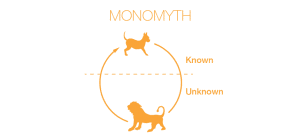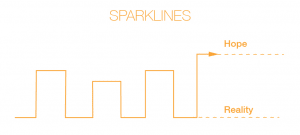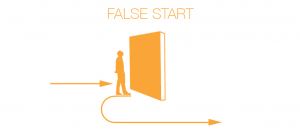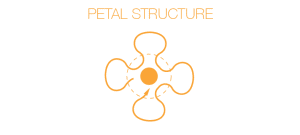Important Storytelling and Narrative Techniques for Impressive Presentation Design.

Almost all known stories, tales, fables speak about similar issues: the search for the lost; sharing things, even if it is very little; relinquishing the most loved ones; dragons, monsters, evil witches and sorcerers; the struggle to take the crown; the end is the winning of the good, the marriage and the happy end to the most beautiful princess or handsome prince as a reward. Why do some of them disappear while some are remembered for thousands of years?
The answer is actually quite simple: those that have influenced us and succeeded in coming into our lives are only the ones with wonderful stories and narrative.
Akira Kurosawa, one of the famous names in the history of cinema, emphasizes the importance of ‘how to tell’ as much as ‘what to tell’.
“With a good script a good director can produce a masterpiece; with the same script a mediocre director can make a passable film.”
Ability and imagination, of course, cannot be indispensable to be a good director, or to be a good narrator. Well, is the secret of this work hidden in talent? Of course, not. The only thing we see when we look at unforgettable movies, theater plays, shows or presentations with a more academic and scientific perspective to uncover the gates of this secret will be the perfect harmony of ability and technique.
Correct narrative for perfect presentations
Narrative means, in the simplest terms, how your idea or story will be conveyed to the audience. Narrative is structured usually in the form of events that happen to characters and their experiences in cinema and literature. The presentation is also similar, but essentially the content is constructed in the context of events and thoughts with the narrative technique determined to reveal the message and is conveyed in a narrative that is of interest to the audience.
Of course, storytelling is not compulsory in every presentation; it is a choice. Stories built with the right technique and used in the right place allows the audience to find the information given interesting, while adding meaning, focus and target characteristics to the presentation. For these reasons, narrative that determines between being a speaker and being a director of the presentation is often overlooked, but in fact it is a vital concept.
We can say that narrative is a common feature of perfect presentations in every field, although it varies structurally depending on what the sector is, who the audience is or what purpose is. You might be out on the stage to talk about any subject from the quality of the production in this year to a planned change in a department. It does not have to be very interesting or change everybody’s life in order to be impressive. To influence people, to transform even the most boring topics into a pleasing presentation, you need to construct the narrative structure with the right techniques. Thus, you can convince the investors, have loyal customers, and increase the productivity of your employees.
As mentioned earlier, the films we watch, the speakers we listen to, and the novels we read… They all make a difference according to the power of the basis they are constructed on, or they get lost in the past.
Well, what is this basis?
First, the current situation is explained, and then it turns out that there are alternatives. The hero is in conflict on the way to defending or pursuing the alternative, and finally reaches a solution. At the moment of solution, the audience is expected to have a catharsis. An effective narrative can be recognized according to whether it causes catharsis or not.
Let’s take a look at the narrative techniques together.
Hero’s journey has been used throughout history in many tales and mythological stories. In this technique, the hero departs from a known place, for a challenging journey to a dangerous and unknown place. After a great adventure, he returns home with a reward at the end of his journey.
By using a hero’s journey, you can make the path to the message you pursue to deliver in your presentation much more impressive. You can use this technique to emphasize what can be done to overcome a particular problem, the achievements in the end and your problem-solving skills.
Japanese yo-yo world champion BLACK tells the inspiring story of finding his life’s passion, and his challenging journey to be the world champion. While he finishes his conversation, he completes the cycle by sharing his new skills with the audience.
Mountain technique is used especially to reveal the tension and drama of a story. We see the beginning and development of an event as in the hero’s journey. The different feature is the continuous ups and downs.
Through these ups and downs, you can emphasize how rugged the path is to get results in professional life and the fact that you have to work without giving up. Because the entire road must be taken to reach the great end. This technique increases the tension gradually, which makes the result much more impressive.
Aimee Mullins uses the mountain structure to tell a personal story – from her birth without the fibula bones on the lower legs to becoming a famous athlete, actor and model.
Nested loop is a narrative technique that nests three or more narratives. It is set by locating the most important narrative in the center and through the use of other narratives to explain this narrative.
You can think of nested loop as: a friend of yours tells you a story that a wise person tells them. This story teaches an important lesson. Although it may seem a bit confusing at first glance, let me summarize: the first cycle is your friend’s own story while the last cycle is wise person’s story. At the center there is an important lesson that the story turns around.
This technique helps you explain what you are inspired to when you have a certain result and how you are shaping the process. For this, you can describe what you did when you encountered problems and the ideas and the practices that changed the course around the concept in the center. It is important to underline how important the center is by keeping it steady constantly.
Chimamanda Ngozi Adichie uses the framework of her experiences in university and the way that Africa is perceived in the Western world to drive home her argument about stories.
The sparklines technique gives your presentation a two-tiered structure. This technique presents two different perspectives: facts and ideals and helps us see what is happening and what can be done.
Thus, the attention of the audience can be drawn to the problems you want to reveal, creating a desire to make a difference in them. It is used as an effective motivating technique for the audience to support and persuade you. You can create hope and excitement with this technique, which compares ideals with facts.
The speech of Martin Luther King, known as “I have a dream”, is one of the best-known examples of this technique because it speaks of the difference between the ideal world and the real world.
Entering from your most exciting part in your presentation is a common technique of storytelling of impressive presentations. Before telling how it started and how it happened, you can activate the audience with exciting information. Later they will be eager to learn the story of this information and they will hang on your every word. Make a sensation at first and explain this sensation reasonably.
One of the things you need to be aware of, if you use this technique, is not to give too much information. Attract the attention of the audience, but leave it on the level that the audience will wonder to get more. I suggest this technique for shorter presentations because when you go back from the middle of the subject, the audience may feel lost until you complete the story.
Zak Ebrahim begins his talk with the revelation that his father helped plan the 1993 World Trade Centre bombing. His audience is gripped from the beginning, as he begins to recount the events of his childhood and the path he took after his father’s conviction.
You can use converging ideas to describe the convergence of different ideas to form a single product or idea. It is an effective way to show the emergence of a product or idea starting from scratch.
It helps explain how equally important stories are used to come to the conclusion. It may be preferable to tell the stories of established partnerships. So you can reveal great ideas and tell how important results come from the ordinary-looking details.
John Bohannon and the Black Label Movement explain (verbally and through dance) how scientists and dancers came together to form an exciting, dynamic alternative to boring presentations.
The feature that makes the false start technique impressive is that the audience is shocked. You need to surprise the viewer by telling a story that is possible but incorrect, but then suddenly transforming the story.
This technique is especially used to talk about events that you get good results after trying again when you are about to fail. It provides a perfect narrative for telling what you have learned from this experience or which innovative methods you used to solve problems. So you can reverse the audience’s expectations and make sure that they are all ears.
J K Rowling begins her speech at Harvard in a typical fashion. She talks about her time at university and the expectations of her parents. The audience expects her to talk about the growing success of her writing career – instead she focuses on a time in her twenties where she felt she had ‘failed’ in life. What comes next is inspirational.
Using petal structure you can tell stories around a certain concept. This technique will provide an impressive fiction for presentations involving more than one speaker. It helps you bring together stories that are independent of each other but serve the same concept.
Explain the individual stories first; each story has its own set of complete narratives, even if it paves the way for the next one. Then reveal the importance of the main message by showing the audience how all these stories relate to each other.
Simon Sinek! His theory might lend itself perfectly to nested loops, but he himself chose to deliver his talk in a petal structure. He tells his audience a series stories to help illustrate his ideas, each one strengthening his message further.
Final words
Narrative techniques should be chosen as to how you deliver your main message and how you want to influence the audience. You need to identify and develop the most appropriate technique to surprise people, make it easier to follow the flow, and reveal your message in a stronger way.
Turning your presentation into a report or tale makes it difficult to notice your main message. When the right technique is used, you gather the attention of the audience until you leave the scene.
In addition to narrative techniques, you can take a look at my post that will help you draw attention of the audience for my presentation design suggestions.
Thanks so much Ffion Lindsay, Karen Dietz, Lori L. Silverman, Gavin McMahon, Nancy Duarte for their inspirational articles.












